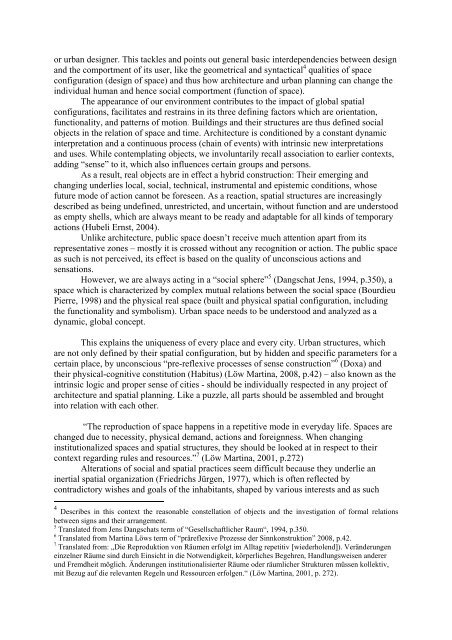HOW CAN PARTICIPATORY PRACTICES HAVE AN INPACT ON ...
HOW CAN PARTICIPATORY PRACTICES HAVE AN INPACT ON ...
HOW CAN PARTICIPATORY PRACTICES HAVE AN INPACT ON ...
You also want an ePaper? Increase the reach of your titles
YUMPU automatically turns print PDFs into web optimized ePapers that Google loves.
or urban designer. This tackles and points out general basic interdependencies between design<br />
and the comportment of its user, like the geometrical and syntactical 4 qualities of space<br />
configuration (design of space) and thus how architecture and urban planning can change the<br />
individual human and hence social comportment (function of space).<br />
The appearance of our environment contributes to the impact of global spatial<br />
configurations, facilitates and restrains in its three defining factors which are orientation,<br />
functionality, and patterns of motion. Buildings and their structures are thus defined social<br />
objects in the relation of space and time. Architecture is conditioned by a constant dynamic<br />
interpretation and a continuous process (chain of events) with intrinsic new interpretations<br />
and uses. While contemplating objects, we involuntarily recall association to earlier contexts,<br />
adding “sense” to it, which also influences certain groups and persons.<br />
As a result, real objects are in effect a hybrid construction: Their emerging and<br />
changing underlies local, social, technical, instrumental and epistemic conditions, whose<br />
future mode of action cannot be foreseen. As a reaction, spatial structures are increasingly<br />
described as being undefined, unrestricted, and uncertain, without function and are understood<br />
as empty shells, which are always meant to be ready and adaptable for all kinds of temporary<br />
actions (Hubeli Ernst, 2004).<br />
Unlike architecture, public space doesn’t receive much attention apart from its<br />
representative zones – mostly it is crossed without any recognition or action. The public space<br />
as such is not perceived, its effect is based on the quality of unconscious actions and<br />
sensations.<br />
However, we are always acting in a “social sphere” 5 (Dangschat Jens, 1994, p.350), a<br />
space which is characterized by complex mutual relations between the social space (Bourdieu<br />
Pierre, 1998) and the physical real space (built and physical spatial configuration, including<br />
the functionality and symbolism). Urban space needs to be understood and analyzed as a<br />
dynamic, global concept.<br />
This explains the uniqueness of every place and every city. Urban structures, which<br />
are not only defined by their spatial configuration, but by hidden and specific parameters for a<br />
certain place, by unconscious “pre-reflexive processes of sense construction” 6 (Doxa) and<br />
their physical-cognitive constitution (Habitus) (Löw Martina, 2008, p.42) – also known as the<br />
intrinsic logic and proper sense of cities - should be individually respected in any project of<br />
architecture and spatial planning. Like a puzzle, all parts should be assembled and brought<br />
into relation with each other.<br />
“The reproduction of space happens in a repetitive mode in everyday life. Spaces are<br />
changed due to necessity, physical demand, actions and foreignness. When changing<br />
institutionalized spaces and spatial structures, they should be looked at in respect to their<br />
context regarding rules and resources.” 7 (Löw Martina, 2001, p.272)<br />
Alterations of social and spatial practices seem difficult because they underlie an<br />
inertial spatial organization (Friedrichs Jürgen, 1977), which is often reflected by<br />
contradictory wishes and goals of the inhabitants, shaped by various interests and as such<br />
4<br />
Describes in this context the reasonable constellation of objects and the investigation of formal relations<br />
between signs and their arrangement.<br />
5<br />
Translated from Jens Dangschats term of “Gesellschaftlicher Raum“, 1994, p.350.<br />
6<br />
Translated from Martina Löws term of “präreflexive Prozesse der Sinnkonstruktion” 2008, p.42.<br />
7<br />
Translated from: „Die Reproduktion von Räumen erfolgt im Alltag repetitiv [wiederholend]). Veränderungen<br />
einzelner Räume sind durch Einsicht in die Notwendigkeit, körperliches Begehren, Handlungsweisen anderer<br />
und Fremdheit möglich. Änderungen institutionalisierter Räume oder räumlicher Strukturen müssen kollektiv,<br />
mit Bezug auf die relevanten Regeln und Ressourcen erfolgen.“ (Löw Martina, 2001, p. 272).


